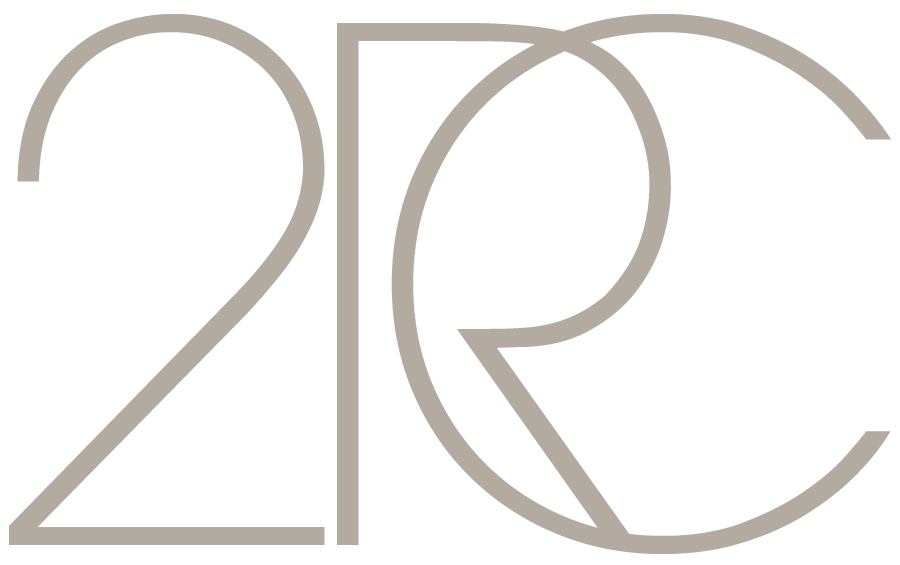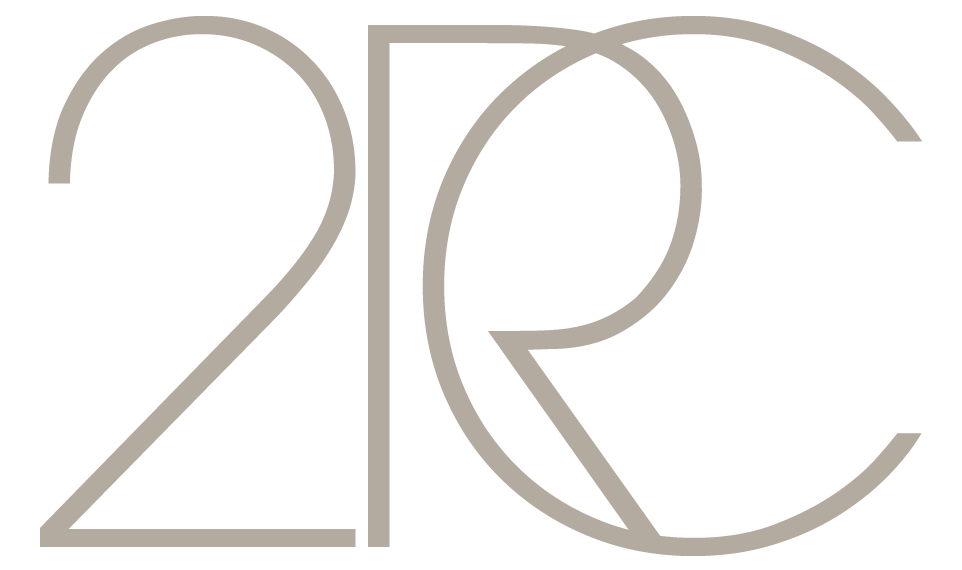About Us

2RC - The history 1959 - 2007 / told by Marianna Vecellio
Nn 1959 Valter and Eleonora Rossi, two young people from the Brera Academy, founded 2RC Stamperia d'Arte with their cousin Franco Cioppi in Rome with the conviction that graphics are a real artistic genre, like painting and sculpture and not an extension of the latter: the goal is to create a technical laboratory that develops the disparate techniques of graphics in order to allow artists to work freely as with other media.
Lucio Fontana: the beginnings
In the early 60s Valter and Eleonora Rossi printed their first graphic folder in Rome: a series of aquatints and etchings made by Fontana. The folder will allow him to win the first prize for graphics in Tokyo.
Lucio Fontana together with Alberto Burri represented one of the most significant voices of the postwar period. His approach to matter, the cuts and holes made on the canvas represented the experiments on new spatial concepts. Bringing them back into engraving had to become proof that the printing techniques preserved on the one hand the tactility of the surface peculiar to the paper medium, while keeping alive the articulated texture of Fontana's works.
Thus began the activity of 2RC which from the very beginning reveals a marked propensity to collaborate with artists who move on the most advanced researches. Between 1962 and 1969 they print with 2RC: Alberto Burri, Giò Pomodoro, Giuseppe Capogrossi, Giulio Turcato, Giuseppe Santomaso, Piero Dorazio, Pietro Consagra, Achille Perilli, Beverly Pepper, Adolph Gottlieb and Afro.
The profound respect for art, a need for adventure, pictorial and sculptural knowledge and the ability to grasp the distinctive touch of each artist, push the Rossi, with great professional accuracy, to the desire to graphically produce the processes and contents expressed by contemporary artists and lead them to courageous experimentation.
Vittorio Rubiu about the engravings of Alberto Burri, with whom the Rossi printed from '62 to '83, speaks of “… engravings closer to painting, almost to be exchanged with it…”; the Reds restore the effect of burnt plastic and the variations of white through the use of acetate, transparent and colorless plastic, while they bring the materiality of the Cretti to the paper through an elaborate and unconventional system of etching and aquatint.
1969 - UNESCO folder: the years of consolidation
The large dimension becomes a place of action, an accessible surface ready to unleash deceptions and continuous tests, which the artist resolves by putting himself back into the hands and wisdom of the engraver and also the place of the adversity of color, of which Eleonora Rossi brings a great sensitivity, tonal passages that the Reds love to find in their lives, because for the Reds, working is a condition of love.
The English artists: Pasmore, Sutherland, Moore and Bacon
Victor Pasmore, an artist recommended to Valter Rossi by Burri on the occasion of the Unesco portfolio, worked with 2RC continuously, from the end of the 60s until his death in 1998.
Rome became in those years a favorite stop for Pasmore, when from Malta, where he had settled since the late 60s, he returned to London to take up his position as Director of the Urban Plan. He loved to stay there and produce some works with the Reds, reproducing his biological forms, from the lights of the Mediterranean Sea that so much Eleonora Rossi knew how to guess and create.
Graham Sutherland confronts the Reds with the problem of aquatint: a solitary artist, he shares with the couple his search for a sign burned by time. He made in his studio in Menton in France in 1977 “Bees”, api series, and in 1979 “Le bestiaire”, inspired by the tale of Apollinaire. The graphic work carried out in the early 80s by Henry Moore is summarized by the words of Giulio Carlo Argan, who observes the sculptor's ability to be able to give with a single graphic sign the limit of the natural horizon and the sculptural one of the human figure. The difficulty of transferring the plastic work on a two-dimensional surface is not a limit to the creation for the master engravers, but an inspiration for a spatial research that takes place in the sign and in the color. Moore's enthusiasm would have been such that he decided to lend the Rossi five large sculptures on the occasion of the inauguration of the new printing house, Vigna Antoniniana Stamperia d'Arte in Rome in the new headquarters at the Baths of Caracalla.
At the end of the 80s, the Reds saw one of the greatest wishes of their career come true: Pierre Levé, the then director of the Marlborough Gallery in New York, proposed that he make an engraving with Francis Bacon. The English artist, a character as lovable as he is tiring and complex, fails to start from the blank sheet. Bacon shuns graphics convinced of the impracticability of the medium, then comes the orange and it is the shock.
By superimposing the plates, Eleonora Rossi manages to give life to a color that the English artist thought was impossible in graphics: a specific orange, intense and infinite. It is the beginning of a series of etchings abruptly interrupted by the artist's death.
This experience is for the Reds yet another lesson: graphics must not be worked on immediately; it does not have to solve the problems of distributing an image, but it is a means capable of expanding the need for experimentation, made up of mutual exchange of understanding and generosity between the artist and the printer.
New York
The 70s were gray years in Italy, the collaboration with overseas artists and the political difficulties of the time led the Rossi, in 1979, to open a printing house in New York, which was the beginning of a profitable work phase. .
The Rossi's desire is to establish a solid dialogue with the American artists with whom they had been working for years, giving an overseas reference, to create the print vouchers then pulled in Italy, and to establish themselves with an international presence.
There are many experiences and episodes of those years: the calligraphic expressionism of Pierre Alechinsky, the first to inaugurate the press in New York; the numerous trips to California and the itinerant print shop reduced to the essentials for Sam Francis; George Segal in 1987 in New York realizes the series of six graphic works “Portraits”; Helen Frankenthaler, Nancy Graves and Julian Schnabel.
The Rossi's decision to open the printing house in New York coincides with the appearance in the Big Apple of some young Italian artists gathered around the Transavantgarde movement and led by the critic Achille Bonito Oliva: they are Francesco Clemente and Enzo Cucchi. The collaboration with the Transavan-guard could not but begin with an interesting conversation with Achille Bonito Oliva, who immediately identifies the intrinsic nature of the graphic medium: the two-way relationship between the artist and the engraver to which the artist delivers the sign.
The assimilation capacity of Francesco Clemente's technique distinguishes him from the beginning from other artists. He combines the fluid line of engraving with the fine watercolors of aquatint, reproducing the brightness of his paintings on paper. In those years Francesco Clemente introduces Julian Schnabel to the Rossi, together they create a series of large-format engravings: each engraving is like a happening, it becomes the implementation of an instinct and the sign a paw.
Recent years
“Each artist brought something and they all enjoyed it”, says calmly Valter Rossi, when retracing the history of 2RC. It tells in enthusiastic tones the open and collaborative attitude of the printing house that has been able to adapt to the needs of artists and transform itself from time to time. Today the printing house resides on the Cassia awaiting a definitive and emblematic location, already defined. The work of graphics is incessant and, retracing the teachings acquired in the past, it becomes history and baggage of mutual exchange between the artists of the past and the artists of today.
2RC - The story 2007 - 2019 / told by Antonio Spiezia
Traveling exhibition
In April 2007, at the Arnaldo Pomodoro Foundation in Milan, the retrospective exhibition curated by Prof. Achille Bonito Oliva was inaugurated "Double dream of art - 2RC between artist and creator" in which 400 graphic works of 2RC were presented. This exhibition date, reduced to 176 large works, in 2008, was presented at the Museum of the Russian Academy of Art in Moscow and at the Academy of Fine Arts in St. Petersburg;
On January 18, 2009 the “traveling exhibition” was inaugurated at the CAFA museum, Central Academy of Fine Arts in Beijing, hosted by important museums of Chinese academies such as: the Luxun Art Academy Museum in Shenyang and the Sichuan Fine Art Institute Museum in Chongqing; in South Korea, at the MOA - Museum of Art of the Seoul National University, where on that occasion the exhibition was inaugurated by our President of the Republic Giorgio Napolitano; continued to travel to Indonesia in Jakarta, Bandung and Yojakarta; Mexico, at the Museo de la Estampa in Mexico City, Querataro, Morelia and Toluca. Returning to Italy in 2013.
China
The change of course took place in 2005, when her daughter, Simona, who had been studying Chinese for some years in Italy and in Beijing, through the Italian Embassy, managed to have an appointment with Prof. Tan Ping, the then director. of the CAFA Central Academy of Fine Arts in Beijing. They learned, but only later, that he was a great enthusiast and competent in graphics.
At the end of the meeting, Tan Ping shows Simona a model of the future CAFA museum designed by Arata Isozaki and tells him “we will do the exhibition here and it will be at the end of 2008.
Tang Pin's appreciation is such, after having seen the exhibition at the Arnaldo Pomodoro Foundation in Milan "Double dream of art - 2RC between artist and creator" to propose to the Rossi a strong collaboration with his Academy, at CAFA.
On January 18, 2009 the scheduled exhibition was presented and the donation by 2RC of a large "Decebalo" chalcographic press, with all the necessary equipment for the activation of the new engraving department "2RCCAFA" to the Beijing Central Academy of Fine Arts
The department, in addition to benefiting from Rossi's teaching on techniques and applications for professors and students, had the opportunity to work with important artists and, in a short time, to see the great results, including economic ones, for the department itself.
The collaboration with the Academy increased as they worked continuously from spring until the beginning of winter for about two or three months.
Tan Ping was the first artist who inaugurated the department with two splendid engravings; The second Lui Ye, an artist who at that time was in a strong crisis and at first it was difficult to convince him. but after having worked with the Reds in 2010 making two engravings, with his traditional characters, the following year when the Reds arrived in Beijing, he showed him a small watercolor where, with very few, sure brush strokes, a new character of his appeared "Pinocchio ”, Adding:“ I'd like to make your Pinocchio in engraving… but great! Pinocchio is an Italian character, I thought it up for you ”; Then, he pulled out of his pocket, the first edition of Pinocchio, translated into Chinese from 1936, which had been given to him by his grandfather when he was 5 years old.
Over the next seven years, with a turnover of dozens of students, they managed to train, according to their needs, four technicians who were so good that they were then hired by the Academy itself; the same criterion that, as I will explain later, the Rossi, also confronted with various friends, including myself, then tried to adopt in Viareggio.
Returning to China, in that period 40 etching editions were made with the most important Chinese artists such as Tan Ping and Liu Ye already mentioned, Ji Dachun, Zeng Hao, Zhang Xiaogang, Ding Yi and Zhang Enli; and finally in 2014, a Western artist, Francesco Clemente, was invited to Beijing for the first time, where he will make the great engraving "The History of a Heart in three Rainbows" with the collaboration of the whole academy and his colleagues. , Chinese artists, who passed through there every day.
Also in China, for Zhang Xiaogang, a very important Chinese artist also internationally, our nomads once again organized a small printing house in his studio, because the artist, very reserved, did not accept to work in the Academy.
In this natural and simple climate, two series of small engravings were born: the first of three and the other of nine prints, for which the artist with an intuition, which we could define sacred, typical of Chinese culture, relied completely on hands of Eleonora aware of the magical qualities of which she is endowed in the creation of color.
Viareggio
During the same 2009, the dear friend Sen. Giovanni Pieraccini proposes to Valter Rossi to open a School of Graphics in Viareggio, at the Gallery of Modern and Contemporary Art - GAMC - and here the collaboration begins in order to find the necessary agreements for to be able to make, on the basis of a specific project, a quick and feasible program with the Municipality of Viareggio.
The Nando Peretti Foundation finances the start-up of the “Master” project to transport the chalcographic presses and all the other machinery and equipment necessary for the start-up of a new printing plant to Viareggio.
In 2010, the Municipality of Viareggio made available to the project a space adjacent to the Palazzo delle Muse - headquarters of the GAMC - to create the 2RCGAMC International Center for Art Graphics and the related teaching rooms.
With the PIUSS funding (acquired by the Municipality of Viareggio in 2012) and ARCUS Spa (2013), the restoration and adaptation works of the “Center” and of the rooms used as classrooms were completed.
From 2010, contacts with the Academy of Florence began - with the then President Paolo Targetti - and, from that moment, work began on the creation of the Master with the Director Eugenio Cecioni - at the time Director of the Master - and the Director Giuliana Videtta.
The first edition of the Academic Master, under the presidency of Claudio Modica, in "Technique and management of the Press and Art Publishing", took place in the 2014/2015 academic year, in the Viareggio headquarters where, in addition to the lessons theoretical by the professors of the Academy, 80% of the practical laboratory lessons were held by Valter Rossi, his wife Eleonora and his staff.
Finally, the students obtained their diploma with the highest scores, despite the many difficulties and inconveniences faced and only partially overcome, caused by the continuous political / administrative changes in the Municipality of Viareggio.
In October 2015, within the GAMC exhibition spaces, the end-of-master exhibition of young artists entitled “Balance” was inaugurated.
Six young artists have been accredited from the first-level Master in "Technique and Management of Print and Art Publishing" which was achieved thanks also to the Candido Sperone and Carla Fendi Foundation and the Nando Peretti Fondation and Elsa Peretti; three of whom, thanks to their generosity, benefited, in March 2016, from a scholarship for one year of internship.
In the program it was established that, in addition to their artistic research work in the various engraving techniques, it was necessary to be able to print, with group cohesion and maximum responsibility, demanding editions of important contemporary artists.
The first artist was Sandro Chia with whom, in 2014, we began the experimentation from where the publication of the book “Six Songs” was born in 2017.
The second, dear friend Carlo Guarienti with whom, in May 2018, the printing of four small graphic works entitled "Disappear .. by the poet Roberto Capuzzo entitled “Senza Regola; The book was published by the publishing house ORI and by 2RC Edizioni d'Arte, and presented to the public on various recent occasions.
The third and last artist, in chronological order, is Danilo Bucchi with whom, during the summer / autumn of 2018, a white on white engraving entitled "Homage to White" was created.
However, the year 2018 did not serve to clarify, with the Municipality of Viareggio, the continuity relationship of the Courses; As, without the teaching rooms, used by the Municipality for different purposes, it has not been and will not be possible for the future to be able to resume the Masters with the Academy of Florence; But, a new perspective has opened with Florence, the possibility of being able to take advantage of a space adjacent to the Academy, to create a new cultural activity together.
Urbino
In 2017, Simona Rossi is contacted by Giuseppe Balduini - of the Municipality of Urbino - who, during a visit to the 2RC Gallery, takes a look at the prints of Arnaldo Pomodoro and asks to be able to create an exhibition of the artist's graphics in the Albani Gallery. of Urbino, owned by the Municipality and of which he is director.
Valter, considering the importance of the Academy and the School of the Book of Urbino, believed it was time to implement his idea "Ethical Archive", to link private structures with the public ones, in order to create a structure that would give guarantees to the public, collectors and the State, of the originality of the works, of the methods used and of its creators: Artists, Publishers and Gallerists. This, again to affirm the importance of creating a work that was classified as "Graphic Art", and not a simple reproduction.
Certainly, the initiative was particularly appreciated by the School of the Book of Urbino with which, as early as May 2019, a project as part of the school work program will be implemented in Viareggio.
This pleasant collaboration with Urbino could also, in a short time, lead the Rossi family to seriously consider the activation of a laboratory in a suitable and stable municipal office; But, on condition that there is a common program and strong cohesion with the Lyceum, the Academy and the local Printing Houses, under the aegis of a Municipality that must be the point of reference and attention, with the right responsibility.


